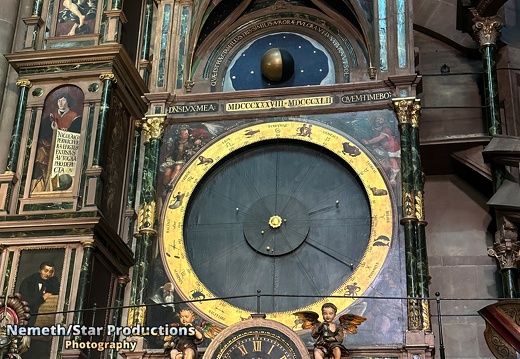
EP01 - Sundial in the Cathédrale Notre-Dame de Strasbourg
Welcome to the new season of SPACE-FRIDAY Photography, beginning in France! Today, we’re taking you on a journey to the past as we explore the Cathedrale Notre-Dame in Strasbourg. Our focus? The magnificent Sundial of the Cathedral. This historic timepiece, dating back to 1843, marks the third clock to grace this iconic location since France’s earliest possession of the city.
Among its remarkable features are a perpetual calendar, including a *computus* calculation, an orrery displaying the positions of planets, and a precise depiction of the Sun and Moon’s real-time locations, even forecasting solar and lunar eclipses. However, the true spectacle lies in the daily procession of Christ and the Apostles, standing 18 inches tall, occurring precisely at solar noon, accompanied by the crowing of a life-size cock three times.
The clock’s gold hands indicate mean solar time, or “temps moyen,” while the silver hands display Central European Time, labeled “heure publique.” Notably, during winter, mean solar time trails approximately 30.5 minutes behind Central European Time.
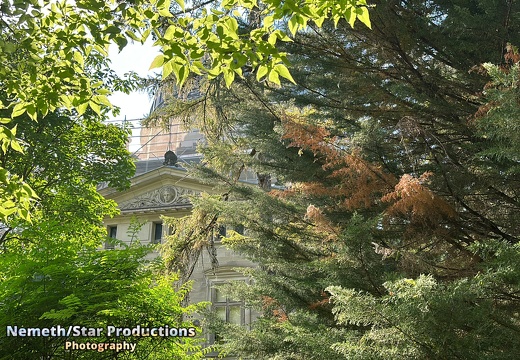
EP02 - Strasbourg Planetarium
The Astronomical Observatory, the first building of the university complex, was erected in 1877 and inaugurated in 1881. It was crucial to isolate this place from urban emissions and disturbances from other institutes to enable precise observations. Hence, Hermann Eggert, the architect of the Imperial University, chose to build the structures away from the university grounds, surrounded by a vast undeveloped area, encompassing both the Botanical Garden to the north and west and the Astronomical Institute to the south. In the imagery from around 1880, the fences of the Botanical Garden and Rue de l’Université were not yet erected. The observatory’s large dome houses an equatorial telescope with an aperture of 49 cm, which was considered the best in the German Empire upon its installation in 1881. Today, it ranks as the third largest dome in France, following those of the observatories in Meudon and Nice. During the renovations conducted at the time of our shooting at the Planetarium Strasbourg, we could only observe it from the outside.
This episode is published under CC-BY 4.0
Please credit as follows
Photo: Sven Nemeth
Published by: Nemeth/Star Productions (https://nemethstarproductions.eu)
You can now join our new Signal group “SPACE-FRIDAY: The Talk”, to talk with people about Astronomy, Science & Space.
https://signal.group/#CjQKIBZWmt57f4O58ORpQyMj1FbYfWMo3v0WILUxX93IhRIQEhDnyBfyv_7sTW7z6gd_ji5l
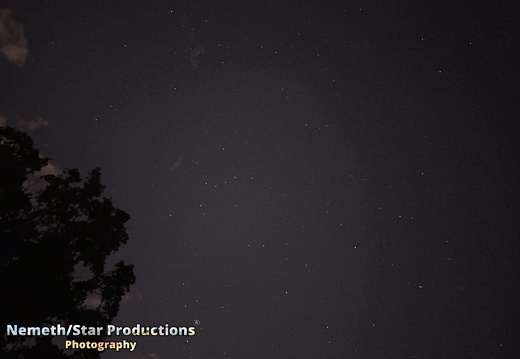
EP03 - Night of the Perseids
Every August, we can enjoy the night of the Perseids. They can be found in the night sky between the constellations Camelopardalis (Giraffe) and Cassiopeia.
We start this episode at the zenith of the sky with the constellations: Cepheus (with the star Alderamin), Cygnus (with the stars Deneb, Sadr, Aljanah, Fawaris), Delphinus, Draco (with the stars Eltanin, Rastaban), Sagitta, Hercules, Lacerta, Lyra (with the star Vega), Pegasus (with the stars Scheat, Matar), Equuleus, and Vulpecula.
We can also see the supernova remnant NGC 6960 and the star regions Veil Nebula and North America Nebula.
The home of the Perseids is between the constellations Camelopardalis and Cassiopeia. We also observe other constellations in these pictures, such as: Andromeda (with the stars Mirach, Alpheratz, Almach), Cassiopeia (with the stars Navi, Shedar, Caph), Cepheus, Lacerta, Pegasus (with the stars Scheat, Markab), Perseus (with the stars Mirfak, Algol), Pisces, Triangulum, Aquila (with the star Tarazed), Delphinus, Sagitta, Lacerta, Vulpecula, and Aquarius.
We can also see the nebula IC 1831 and the Andromeda Galaxy.
All pictures licensed CC--BY 4.0
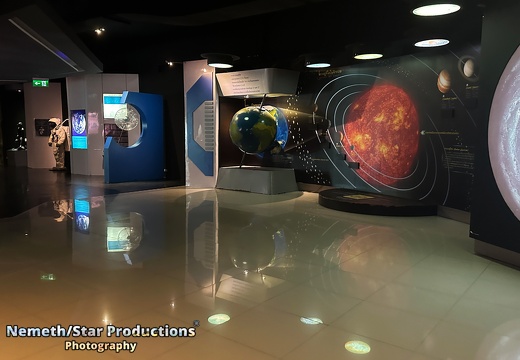
EP04 - Bangkok Planetarium
Welcome to the Bangkok Planetarium, located in Thailand's vibrant capital. Founded in 1964, it is Thailand’s oldest planetarium, situated in the (Bangkapi ) Khlong Toei district along bustling Sukhumvit Road, right next to the Eastern Bus Terminal (Ekkamai). In addition to the planetarium, visitors will find a range of science exhibits showcasing technological advancements in space exploration, the evolution of satellite research, and various natural science themes. Highlights include a dinosaur exhibit and an insect zone, which are particularly popular with young visitors. The interactive displays are largely designed for children and school groups, making it an educational hotspot for families.
Outside the planetarium, a replica of a NASA lunar module invites visitors to explore it up close from all angles. Inside, a permanent exhibition offers scientific and historical insights into astronomy and space exploration, including an astronaut suit and a model of a landing capsule. At the heart of the planetarium lies its impressive domed theater, where captivating shows on astronomy and the cosmos are screened regularly. These shows change every two months, providing visitors with fresh, immersive perspectives on different cosmic themes. It’s the perfect place to escape the city’s bustle, unwind, and learn something new.
In the 1960s, as many countries began to offer astronomy education for students and the general public, Thailand also recognized the importance of astronomy and science education. Following World War II, the population of Thailand grew, leading to an increase in student numbers. The government acknowledged the necessity of extracurricular educational facilities to support access to knowledge and practical science promotion. In 1961, plans were initiated for the construction of a planetarium and observatory as part of an educational enhancement program. The goal was to enable students to learn scientific concepts through realistic simulations, which are more effective and engaging than traditional lecture-based teaching. The educational complex was designed to be easily accessible, safe, and expandable, leading to its construction on the grounds of the Ministry of Education in the Bangkapi district of Bangkok.
The projectors and telescopes were supplied and installed by B. Grimm & Co. Ltd., the representative of the German company Carl Zeiss in Thailand. The equipment costs—including projectors, telescopes, air conditioning, electrical systems, and elevators—amounted to €67,000 (1960s) (9,141,000 Baht), while the building construction costs reached €182,000 (1960s) (3,298,031 Baht). On September 7, 1962, Field Marshal Sarit Thanarat laid the foundation stone for the building, which was constructed with a reinforced concrete structure designed in the style of the Carl Zeiss Planetarium. The building measures 31 meters in width, 38.6 meters in length, and 5 meters in height. The planetarium's dome has a diameter of 20.6 meters and can accommodate 500 visitors. Adjacent to the planetarium is the observatory, also built of reinforced concrete. It measures 5 meters by 5 meters and stands 20 meters tall. The observatory is equipped with a large telescope housed under a metal dome with a diameter of 3.7 meters.
Once construction was completed, the technical team from Carl Zeiss installed the projectors and telescopes, a process that took about five months. On August 18, 1964, King Bhumibol Adulyadej, together with Queen Sirikit, officially inaugurated the planetarium. The first presentation in the planetarium was conducted by Admiral Luang Chonlathanapruttikai. In 2016, the Zeiss Mark IV projector was replaced by a modern Digistar 5 projection system from Evans & Sutherland; however, the old Zeiss projector remains on-site as a historical exhibit.
All pictures licensed CC-BY 4.0
Please credit as follows
Photo: Sven Nemeth
Published by: Nemeth/Star Productions (https://nemethstarproductions.eu)
*This episode was also possible thanks to the eSIM card provider Airalo. Use our link to get discounts to stay connected to the world while traveling.
Stay connected with Airalo: https://airalo.pxf.io/MmkjyJ
Discount code (new costumers): NEWTOAIRALO15
Discount code (existing costumers): AIRALOESIM10
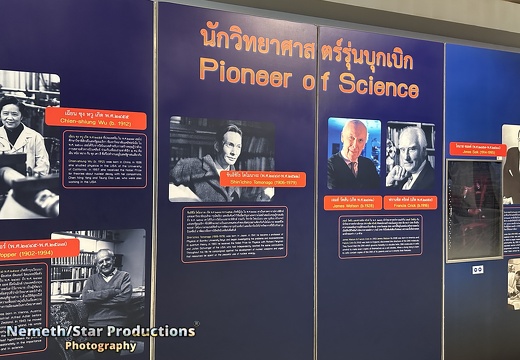
EP05 - Pioneers of Science, TH
At the Pathum Thani Museum Complex, located near Bangkok, you’ll find the Science Museum, home to the Pioneers of Science exhibition. This exhibition highlights the achievements of world-renowned scientists, including Edwin Hubble, Dorothy Hodgkin, Lise Meitner, Chien-Shiung Wu, Karl Popper, Linus Pauling, Marie Curie, Shin’ichiro Tomonaga, James Watson, Francis Crick, and Jonas Salk. The exhibition also features a stunning panoramic image of the planets in our solar system. Another section focuses on asteroids that pass close to Earth, providing fascinating insights into near-Earth objects. The Science Museum Project, initiated in 1992 to honor Queen Sirikit of Thailand's 57th birthday. On November 25, 1994, the cornerstone-laying ceremony for the building in Technopolis, Pathum Thani, was presided over by Mr. Tanin Kraividen, Vice President of the Chulabhorn Research Institute, on behalf of Princess Chulabhorn. The building features a modern architectural design: three large cubes stand on one corner each, providing balance and stability. It was constructed using advanced materials, such as specially coated steel plates and reinforced concrete, ensuring durability and low maintenance. The museum, built on a 180-Rai site, was developed after studies of international science museums. It adopts a modern approach to make science more appealing to the public. It operates as a state enterprise, allowing for greater efficiency and flexibility. The master plan was created in collaboration with British experts.
All pictures licensed CC-BY 4.0
Please credit as follows
Photo: Sven Nemeth
Published by: Nemeth/Star Productions (https://nemethstarproductions.eu)
*This episode was also possible thanks to products bought at Amazon. Use our link to get discounts and support our projects.
DE: https://www.amazon.de/?tag=nemethstarpro-21
ZA: https://www.amazon.co.za/?tag=nemethstarpro-21
US: https://www.amazon.com/?tag=nemethstarpro-20
UK: https://www.amazon.com/?tag=nemethstarp00-21
ES: https://www.amazon.com/?tag=nemethstarp09-21
IT: https://www.amazon.com/?tag=nemethstarp04-21
FR: https://www.amazon.com/?tag=nemethstarp07-21
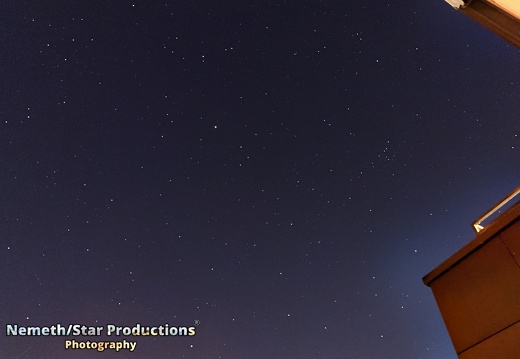
EP06 - Stargazing Tübingen
In June 2023, we had the chance to capture the stunning night sky over Tübingen, Germany. Right on the banks of the Neckar River, we observed and photographed the constellations and their stars. The night sky above Tübingen revealed: Libra (Zubeneschamali, Zubenelgenubi II), Bootes (Arcturus, Izar, Muphrid), Coma Berenices, Canes Venatici, Corona Borealis (Alphecca), Hercules, Serpens (Unukalhai), Virgo (Spica, Porrima), Leo (Denebola), Corvus (Gienah), Hydra, Ophiuchus (Saik), Scorpius (Antares, Dschubba, Acrab), Pollux.
*This episode was also possible thanks to equipment we got on Amazon. Get yours on Amazon:
(ATUMTEK 51" Stand) https://amzn.to/3ZzhYNg
(iPhonePro): https://amzn.to/3ZkDiYD
(Telescope): https://amzn.to/4crNSB8
All pictures licensed CC-BY 4.0








